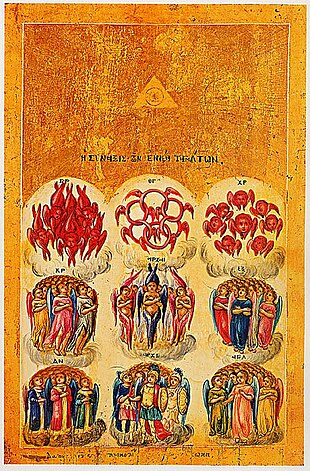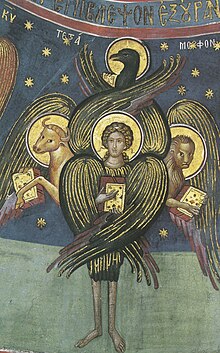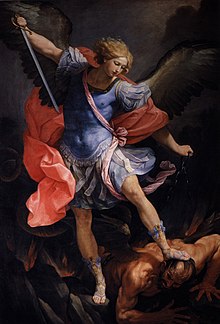Angels in Christianity


| Part ofa serieson |
| Christianity |
|---|
 |
InChristianity,angelsare the messengers ofGod.
General views[edit]
Antiquity[edit]
This sectionneeds expansionwith: A general view of angels according to Christians in Antiquity. You can help byadding to it.(February 2023) |
In chapter V ofIgnatius of Antioch'sLetter to the Trallians,the bishop gives a listing of angels not unlike that later proposed by Pseudo-Dionysius. In hisFirst Epistle of Clement,Clement of Romeexhorts his listeners to join the angels in praising God.Clement of Alexandriawrote that angels “breathe” in men’s thoughts and reasonings, and “puts in” their hearts “strength” and a keener perception.[1] Evagrius Ponticusspoke of the concept of angelic companions and angels as models for behavior.[2]
Augustine of Hipporemarks, the angels were experiencing something new as thecreation of Godunfolded.[3]Augustine also considers that the 'good' angels seek at all times, to direct us towards the true source of happiness, God; that they encourage us inworship of God.[4]
Pseudo-Dionysian hierarchy[edit]
According toPseudo-Dionysius the Areopagite'sDe Coelesti Hierarchia(On the Celestial Hierarchy), there are three levels ( "sphere" ) of angels, inside each of which there are three orders.
Various works ofChristian theologyhave devisedhierarchies of angelic beings.The most influential Christian angelic hierarchy was put forward around the turn of the 6th century CE by Pseudo-Dionysius in his workDe Coelesti Hierarchia.He claimed to be an important figure who was converted byPaul the Apostle,and the Pseudo-Dionysius enjoyed greater influence than it would have if he had used his actual name, untilErasmuspublicised doubts about the age of the work in the early 16th century.[5]
Catholic Church[edit]
According to theCatechism of the Catholic Church(CCC) paragraph 328, "the existence of the spiritual, non-corporeal beings thatSacred Scriptureusually calls 'angels' isa truth of faith.The witness of Scripture is as clear as the unanimity ofTradition."[6]The samecatechismstates: "The whole life of the church benefits from the mysterious and powerful help of the angels [...] From its beginning until death, human life is surrounded by their watchful care and intercession."[7]It also states, "Christ is the center of the angelic world. They areHisangels [...] They belong to Him because they were created through and for Him ".[8]
Seraphim[edit]
Tradition places seraphim in a rank in Christian angelology, based onIsaiah's use of the word. Seraphim angels are the closest to God and lead worship in heaven by singing endless praises to him.[9]
Cherubim[edit]

In theBook of Ezekiel,and in some Christian icons, thecherubis depicted as having two pairs of wings, and four faces: that of alion(representative of allwild animals), anox(domestic animals), ahuman(humanity), and aneagle(birds).[10]Their legs were straight, the soles of their feet like the hooves of a bull, gleaming like polished brass. Later tradition ascribes to them a variety of physical appearances.[10]In Western Christian tradition, cherubim have become associated with theputto(derived from classicalCupid/Eros), resulting in depictions of cherubim as small, plump, winged boys.[11]
Thrones or Ophanim[edit]
Theophanimrefer to the wheels seen inEzekiel's vision of the chariot (Hebrewmerkabah) inEzekiel 1:15–21.One of theDead Sea scrolls(4Q405) construes them as angels.[12]

Dominions or Lordships[edit]
The Dominions (lat.dominatio,pluraldominationes,also translated from the Greek termkyriotētes,pl.ofkyriotēs,as "Lordships" ).[13]Traditionally, they are held to govern the movement of stars, planets, and other celestial objects.[14]
Virtues[edit]
According toThe Etymologies of Isidore of Seville,the Virtues are known for their control of the elements. In addition to being the spirits of motion, they also assist in governing elements of nature, such as storms.[14]They also assist with miracles, as well as encourage humans to strengthen their faith in God.[15]
Powers or Authorities[edit]
InThe Etymologies of Isidore of Seville,the Powers (lat.potestas(f), pl.potestates) (Greek: ἐξουσίαι) are given their name because they are angels who have power over evil forces, which the angels are able to restrain to keep them from doing harm.[15]Powers also oversee the power which human beings—such as kings—have been given in the world.[14]
Principalities or Rulers[edit]
According toThe Etymologies of Isidore of Seville,the Principalities (Latin:principatus), also translated as "Princedoms" and "Rulers", from the Greekarchai,pl.ofarchē(see Greek root inEph 3:10), are the angels that guide and protect nations, or groups of peoples, and institutions such as the Church. The Principalities preside over the bands of angels and charge them with fulfilling the divine ministry. There are some who administer and some who assist.[15][needs update]
An example of a Principality angel that is the subject of cult is theAngel of Portugal.
Archangels[edit]

The wordarchangelis only used twice in theNew Testament:in1 Thessalonians 4:16andJude 1:9.
In most Christian traditions,Gabrielis also considered an archangel, but there is no direct literary support for this assumption. The termarchangelappears only in the singular, never plural, and only in specific reference toMichael.
The name of thearchangel Raphaelappears only in theBook of Tobit(Tobias).
TheHoly See's 2001Directory on popular pietystates: "The practice of assigning names to the Holy Angels should be discouraged, except in the cases of Gabriel, Raphael and Michael whose names are contained inHoly Scripture".[16]
Guardian angels[edit]
A guardian angel is a type ofangelthat is assigned to protect and guide a particular person, group or nation. Belief intutelary beingscan be traced throughout all antiquity. The idea of angels that guard over people played a major role inAncient Judaism.InChristianity,thehierarchy of angelswas extensively developed in the 5th century byPseudo-Dionysius the Areopagite.Thetheologyof angels and tutelary spirits has undergone many changes since the 5th century. The belief is that guardian angels serve to protect whichever personGodassigns them to.
See also[edit]
- Angels in Islam
- Angels in Judaism
- Dynamics of the celestial spheres
- Fallen angel
- Heavenly host
- List of angels in theology
- List of films about angels
References[edit]
- ^"Fathers of the Church Speak on Angels".www.orthodoxprayer.org.Retrieved2023-10-25.
- ^Sinkewicz, Robert E., ed. (2003).Evagrius of Pontus: The Greek Ascetic Corpus.Oxford/New York: Oxford University Press. p. xvii.
- ^Klein 2018,p. 30.
- ^Klein 2018,p. 61.
- ^"Pseudo-Dionysius the Areopagite".The Stanford Encyclopedia of Philosophy.Metaphysics Research Lab, Stanford University. 2019.
- ^"Catechism of the Catholic Church Paragraph 5. Heaven and Earth".vatican.va.RetrievedMarch 4,2022.
- ^Bordwell, David; the Vatican (2002).Catechism of the Catholic Church.Continuum International Publishing. p. 78 §§334–335.ISBN0-86012-324-3.
- ^Catechism of the Catholic Church,§331.
- ^"Seraphim Angels: Burning With Passion for God".Learn Religions.Retrieved2024-05-04.
- ^abWood 2008,pp. 2–4.
- ^Wood 2008,p. 1.
- ^"intertextual.bible | Biblical Intertextuality | 4Q405 | 2 Enoch 20:3".intertextual.bible.Retrieved2024-05-04.
- ^Guiley, Rosemary (1996).Encyclopedia of Angels.New York, New York: Facts on File, Incorporated.
- ^abcKasten, Patricia (2013-12-09)."The angels in charge of nature".The Compass.Diocese of Green Bay.Retrieved2023-10-25.
- ^abcIsidore, Bishop of Seville (July 2006).The Etymologies of Isidore of Seville(PDF).Translated by Lewis, W. J.; Beach, J. A.; Berghof, Oliver; Barney, Stephen. New York: Cambridge; New York: Cambridge University Press. p. 161.ISBN9780521837491.
- ^Congregation for Divine Worship and the Discipline of the Sacraments(December 2001)."Directory on popular piety and the liturgy. Principles and guidelines".www.vatican.va.Retrieved2023-01-15.
Sources[edit]
- Klein, Elizabeth (2018).Augustine's Theology of Angels.Cambridge University Press.ISBN978-1-108-42445-5.
- Wood, Alice (2008).Of Wing and Wheels: A Synthetic Study of the Biblical Cherubim.Walter de Gruyter.ISBN978-3-11-020528-2.
Further reading[edit]
- Patrides, C. A.(1982). "On the orders of angels".Premises and Motifs in Renaissance Thought and Literature.Princeton.ISBN0-691-06505-5.
- Pseudo-Dionysius the Areopagite(1894).The Celestial and Ecclesiastical Hierarchy of Dionysius the Areopagite.Translated by John Parker. Skeffington & Son.

